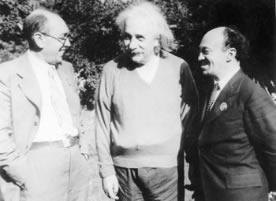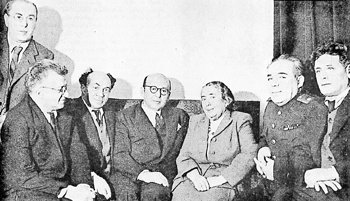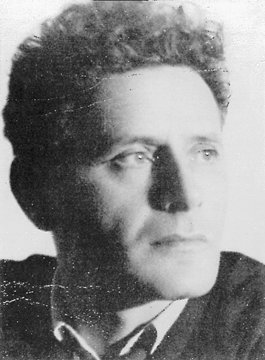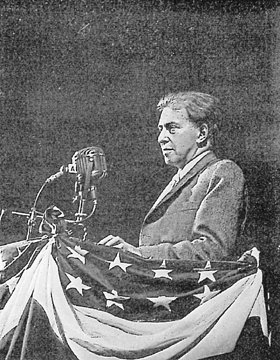Jews in the Soviet
Union from 1941
up to the end of the
Soviet era
(Part 2 of 8)
The Jewish Anti-Fascist Committee
In the campaign to mobilize all resources for the war, the Soviet authorities in April 1942 allow the establishment of the Jewish Anti-Fascist Committee. Its aim is to organize political and material support for the Soviet struggle against Nazi Germany from the Jewish communities in the West. Solomon Mikhoels, the popular actor and director of the Moscow Jewish State Theater, is appointed chairman, and many well-known Soviet Jews participate in the Committee's activities. Since the dissolution of the Yevsektsii in 1930, the J.A.C. is the first specifically Jewish body in the Soviet Union. It has its own newspaper in Yiddish, Eynikeyt (Unity), in which contributions from the most popular Yiddish writers appear.


At your left,
Itzik Feffer and Solomon Mikhoels at a meeting with Albert Einstein during their
trip to the United States in 1943. Albert Einstein, himself a refugee from Nazi
Germany, wrote a preface to the Black Book.
At your right,
Members of the Jewish Anti-Fascist Committee. Left to right: Itzik Feffer (writer),
Samuel Halkin (writer), Solomon Mikhoels (actor; director of the Moscow Jewish
State Theater), Ben-Zion Goldberg (visiting from the USA), Lina Shtern (scientist),
Aaron Katz (Major General) and Peretz Markish (writer).
In 1943 Solomon Mikhoels and the writer Itzik Feffer embark on a seven-month official tour to the USA, Mexico, Canada and Great Britain. They are received everywhere with great enthusiasm: for a long time, no official contact with one of the largest Jewish communities of the world had been possible. Especially in the United States, where many Jews have not forgotten their ties with Russia, the tour is a great success, and many millions of dollars are raised for the Russian war effort.
The J.A.C. becomes the focal point of a national awakening for Soviet Jewry at a time when its very survival is in danger. Many Jews turn to the J.A.C. with requests for help, among them survivors from the Nazi camps who find their houses occupied upon their return.


At your left,
the novelist and poet Peretz Markish, a leading figure in Yiddish literature
and during the war a prominent member of the Jewish Anti-Fascist Committee.
He was executed in 1952 during Stalin's campaign against "Cosmopolitans."
At your right,
he writer Ilya Ehrenburg, speaking in New York in 1946. He was famous for his
outspoken articles against Nazi Germany. Probably because of his close relationship
with many leading artists and writers in the West, he was the only prominent
member of the Jewish Anti-Fascist Committee to survive the purges of Stalin.
The contacts with American-Jewish organizations result in the plan to publish a Black Book simultaneously in the USA and the Soviet Union, documenting the anti-Jewish crimes of the Nazis and the Jewish part in the fighting and resistance.
In 1944, the writer Ilya Ehrenburg sends a collection of letters, diaries, photos and witness accounts to the USA to be used in the book. The Black Book is published in New York in 1946. But no Russian edition appears. The typefaces are finally broken up in the printing press in 1948, a year in which the situation of Soviet Jews has once more deteriorated sharply.